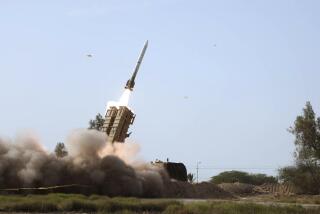Congressional Study Raises Questions on ‘Star Wars’
- Share via
WASHINGTON — A strategic defense against ballistic missiles cannot be designed to protect the entire U.S. population but such a system could force the Soviet Union to increase the number of warheads it would need to aim at the United States to destroy protected military targets, according to a congressional report made public Tuesday.
And combined with a shift in the deployment mode of U.S. missiles, a ballistic missile defense--the heart of the Reagan Administration’s so-called “Star Wars” plan--could protect “a substantial fraction” of American offensive weapons from a Soviet first strike, the report said.
The study, capping a 1 1/2-year review of ballistic missile defenses, was released along with a companion document on the Pentagon’s anti-satellite weapon.
It raised the issue of the impact such a missile defense would have on the strategic stability between the United States and the Soviet Union--pointing out that without regulation of defensive systems, it “could be extremely difficult” to negotiate limits on offensive weapons.
“Unless each side was absolutely convinced that it could not afford to deploy offenses that would counter the other’s defenses, it would have a strong incentive to increase, rather than decrease, offensive arms levels,” the study said.
Both the strategic defense study and the anti-satellite report were completed by the congressional Office of Technology Assessment at the request of the House Armed Services and Senate Foreign Relations committees.
In the House, Rep. Les Aspin (D-Wis.) said that the defense study raised questions about the wisdom of proceeding with the $26-billion, five-year “Star Wars” research program, formally known as the Strategic Defense Initiative.
‘Greater Instability’
“What this means is that after spending billions and billions of dollars, we could find that we have bought ourselves greater instability than the world has ever confronted in the atomic age,” said Aspin, chairman of the House Armed Services Committee.
“Obviously, we wouldn’t agree with that conclusion,” Pentagon spokesman Robert Sims said of Aspin’s remark. He said he has not seen the report, however.
When President Reagan unveiled his ideas for SDI two years ago, he presented it as a program intended to render nuclear weapons “impotent and obsolete”--implying that the goal is the total protection of U.S. cities and countryside.
While some officials have discussed the program in terms of a “point defense” intended primarily to protect the buried silos containing the nation’s intercontinental ballistic missiles, the Administration never formally has departed from the characterization offered by Reagan.
But the congressional report said: “Assured survival of the U.S. population appears impossible to achieve if the Soviets are determined to deny it to us. This is because the technical difficulties of protecting cities against an all-out attack can be overcome only if the attack is limited by restraints on the quantity and quality of the attacking forces.”
Critics of “Star Wars” have said that the Soviets could counter the U.S. defense by increasing their deployment of offensive missiles.
The report said: “The technology is reasonably well in hand to build a BMD (ballistic missile defense) system that could raise significantly the price in nuclear warheads of a Soviet attack on hardened targets in the United States; such a system, if combined with a re-basing of U.S. ICBMs, could protect a substantial fraction of those U.S. land-based missiles against a Soviet first strike.”
“Hardened” targets are those protected against all but direct strikes by incoming missiles.
The report stated that, although the technical level of the Soviet ballistic missile defense is no greater than that of the United States, the Soviets “are almost certainly better equipped in the near-term to deploy a large-scale ‘traditional’ BMD system than we are” because they have a working missile defense production “base.”
Under the Anti-Ballistic Missile Treaty of 1972, the United States and the Soviet Union are each limited to one missile defense system. The Soviets deployed theirs around Moscow, but the United States abandoned, as ineffective in relation to the cost, a system once erected to protect Minuteman missile bases in North Dakota.










